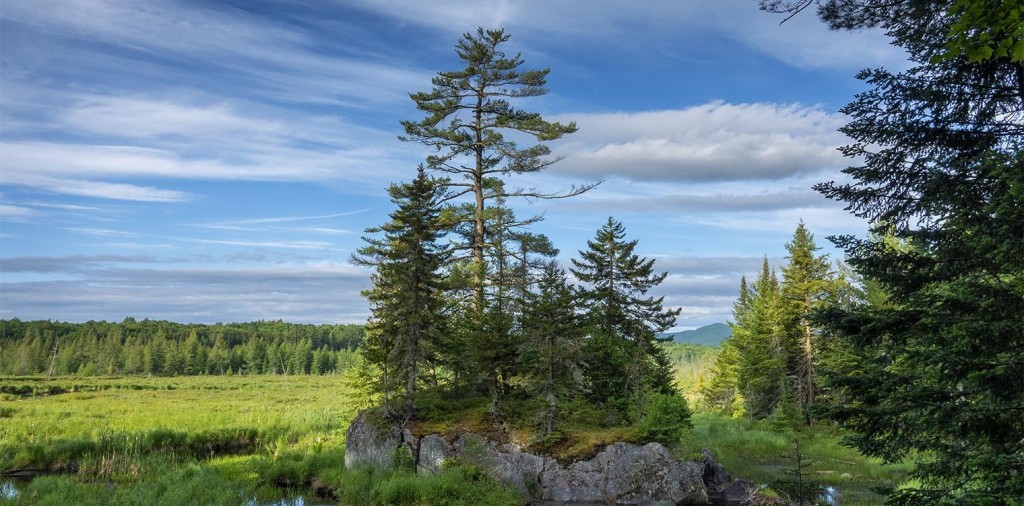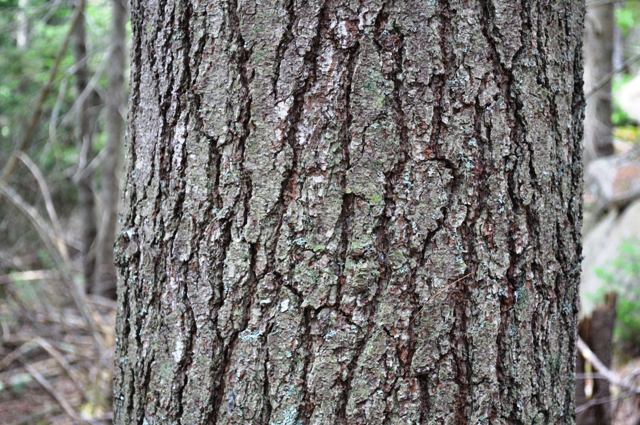White Pine (Pinus strobus)
The white pine is native to the northern and northeastern United States (this includes Minnesota) as well as southeastern Canada.

Distribution of White Pine from USGS (“Atlas of United States Trees” by Elbert L, Little Jr.)
The eastern white pine is generally known for its long thin needles and long woody pinecones. It is commonly used as a Christmas tree. The white pine is a fast-growing tree and can grow 2-3 feet per year. It takes about 25-30 years to reach maturity and can grow over 100 feet tall.

The eastern white pine at maturity has bark that is a reddish-brown gray color with shallow ridges. As the tree ages, the ridges become more pronounced. An immature white pine will have smooth bark with a gray and green color.

The needles of this tree are a medium green color, come in bundles of five, and are about 2 to 4 inches long. The cones are on the longer side being 4-8 inches long and one-inch thick.
White pines are monoecious and have both male and female cones. The male cones release pollen and are a light yellow or golden color. The female cones start out as a yellowish green color and gradually turn brown as they reach maturity. The female cones are larger and have ridges on their surface. During their journey to maturity, the cone will also start to open for the seed to be released into the wind.


When colonists first arrived in America, the white pine was recognized as an ideal tree for ship-building as the trunks made perfect masts. England also recognized the trees significance and designated the best of the trees to be used as the masts for the British Royal Navy fleet. Colonists ignored these designations and fights broke out between them and the English representatives. These tensions lead to the Pine Tree Riot of 1772 and made the pine tree a symbol for liberty, freedom, independence, and strength.
Historically, the eastern white pine played a central role in the lumber industry of Minnesota. The first European immigrants arrived in Minnesota in the 1820s. At this time, there was “19.5 million acres in natural prairie systems and about 31.5 million in forests.” Looking forward to the 1920s, only 0.3% of that original prairie land was present; the forest decreased to less than 18 million acres. Pine was the tree of choice for loggers, so the pine forests were cleared, and aspen and birch trees were planted in their place.
In the 1830s, the lumber industry picked up in Minnesota and Wisconsin, and the pines along the riverbanks were harvested and sent down the river to mills. The eastern white pine was the gold standard. The white pine was the most common tree in the lumber market for 250 years. Due to the mass decimation of the original white pine populations, wood of that quality and species will likely not grow again for many years. By 1945, about 14,831,000,000 board-feet of white pine was processed with about 2.3 billion of those board-feet coming from Minnesota as well as 4.7 million cords from the forests. In the peak year of logging (1900) Minnesota pine alone could have been used to build 600,000 two story houses or build a board walk circling the equator. This trend continued and many more millions of board-feet of wood was harvested.
White pine has a uniform texture and is easy to work with due to its resilience to splitting. It is light weight, resists decay well, and holds paint extremely well. Though it is not the most high-quality wood, due to its ease of processing and its wide availability, it was the lumber of choice. It can be used to build houses and is largely used to build boxes since it is easy to stencil, carve, and paint.
Native American tribes that inhabited Minnesota before the colonists also highly valued the White Pine. The Ojibwe tribe refers to the white pine as “jîngwak kweseskwe’ tûk.” Medicinally, the leaves were dried out and then ground into a fine powder to be used as a reviver inhalant. The harvesting of materials from the white pine is always accompanied by a song to grandmother and the burning of tobacco. The bark and cones were boiled to make a pitch that could be used as a coating for woods to waterproof them. For culinary purposes, the needles were boiled to make tea.
